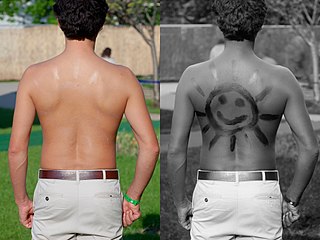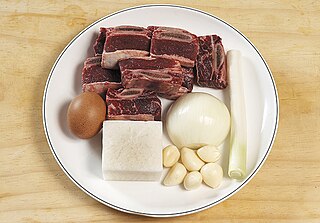
Titanium dioxide, also known as titanium(IV) oxide or titania, is the inorganic compound with the chemical formula TiO
2. When used as a pigment, it is called titanium white, Pigment White 6 (PW6), or CI 77891. It is a white solid that is insoluble in water, although mineral forms can appear black. As a pigment, it has a wide range of applications, including paint, sunscreen, and food coloring. When used as a food coloring, it has E number E171. World production in 2014 exceeded 9 million tonnes. It has been estimated that titanium dioxide is used in two-thirds of all pigments, and pigments based on the oxide have been valued at a price of $13.2 billion.

Oxybenzone or benzophenone-3 or BP-3 is an organic compound belonging to the class of aromatic ketones known as benzophenones. It is a pale-yellow solid that is readily soluble in most organic solvents. It is widely used in sunscreen formulations, plastics, toys, furniture finishes, and other products to limit UV degradation. In nature, oxybenzone can be found in various flowering plants. The compound was first synthesised in Germany by chemists König and Kostanecki in 1906.

Sunscreen, also known as sunblock or sun cream, is a photoprotective topical product for the skin that helps protect against sunburn and most importantly prevent skin cancer. Sunscreens come as lotions, sprays, gels, foams, sticks, powders and other topical products. Sunscreens are common supplements to clothing, particularly sunglasses, sunhats and special sun protective clothing, and other forms of photoprotection.
In high energy physics experiments, an absorber is a block of material used to absorb some of the energy of an incident particle in an experiment. Absorbers can be made of a variety of materials, depending on the purpose; lead, tungsten and liquid hydrogen are common choices. Most absorbers are used as part of a particle detector; particle accelerators use absorbers to reduce the radiation damage on accelerator components.
An excipient is a substance formulated alongside the active ingredient of a medication. Excipients serve various purposes, including long-term stabilization, bulking up solid formulations containing potent active ingredients in small amounts, or enhancing the therapeutic properties of the active ingredient in the final dosage form. They can facilitate drug absorption, reduce viscosity, or enhance solubility. Excipients can also aid in the manufacturing process by improving the handling of active substances, facilitating powder flowability, or preventing denaturation and aggregation during the expected shelf life. The selection of excipients depends on factors such as the route of administration, dosage form, and active ingredient.

Co-codaprin (BAN) is a compound analgesic, a combination of codeine phosphate with aspirin.

Avobenzone is an organic molecule and an oil-soluble ingredient used in sunscreen products to absorb the full spectrum of UVA rays.

Octyl methoxycinnamate or ethylhexyl methoxycinnamate (INCI) or octinoxate (USAN), trade names Eusolex 2292 and Uvinul MC80, is an organic compound that is an ingredient in some sunscreens and lip balms. It is an ester formed from methoxycinnamic acid and 2-ethylhexanol. It is a liquid that is insoluble in water.

Bonjela is a brand of oral treatments intended to relieve the pain of mouth ulcers and denture sores. The brand covers a range of products. Bonjela Adult and Cool are oral gels containing keratolytic and mildly antiseptic salicylic acid in the form of its salt choline salicylate and the antiseptic cetalkonium chloride as active ingredients.

In a general sense, an ingredient is a substance which forms part of a mixture. In cooking, recipes specify which ingredients are used to prepare a dish. Many commercial products contain secret ingredients purported to make them better than competing products. In the pharmaceutical industry, an active ingredient is the ingredient in a formulation which invokes biological activity.

Co-dydramol (BAN) is a non-proprietary name used to denote a particular compound analgesic, a combination of dihydrocodeine tartrate and paracetamol. Co-dydramol tablets are used for the relief of moderate pain. Co-dydramol is part of a series of combination drugs available in the UK and other countries including co-codaprin.

UV filters are compounds, mixtures, or materials that block or absorb ultraviolet (UV) light. One of the major applications of UV filters is their use as sunscreens to protect skin from sunburn and other sun/UV related damage. After the invention of digital cameras changed the field of photography, UV filters have been used to coat glass discs fitted to camera lenses to protect hardware that is sensitive to UV light.

2-Ethylhexyl salicylate, or octyl salicylate, is an organic compound used as an ingredient in sunscreens and cosmetics to absorb UVB (ultraviolet) rays from the sun. It is an ester formed by the condensation of salicylic acid with 2-ethylhexanol. It is a colorless oily liquid with a slight floral odor.
Pharmaceutical formulation, in pharmaceutics, is the process in which different chemical substances, including the active drug, are combined to produce a final medicinal product. The word formulation is often used in a way that includes dosage form.
The biological activity of a pesticide, be it chemical or biological in nature, is determined by its active ingredient. Pesticide products very rarely consist of the pure active ingredient. The AI is usually formulated with other materials and this is the product as sold, but it may be further diluted in use. Formulations improve the properties of a chemical for handling, storage, application and may substantially influence effectiveness and safety.
Eusolex is the trade name of a number of UV absorbers:
Escalol is the trade name of a number of UV absorbers:

Bar Keepers Friend is an American brand of mass-produced cleaning agents. The original canned scouring powder product has been manufactured and sold since 1882. It was invented by a chemist in Indianapolis, Indiana, where it continues to be manufactured by SerVaas Laboratories. The canned product's primary active ingredient is oxalic acid. Bar Keepers Friend has various cleaning uses.
A Certified Organic Sunscreen, also known as Petrochemical-Free Sunscreen, is a third party certified sunscreen product consisting of certified and approved organic ingredients, with typically zinc oxide acting as the photo-protector. An organic sunscreen is verified and approved by a certifier to international or national organic standards, such as NSF/ANSI 305 and USDA organic, which define production and labelling requirements for personal care products containing organic ingredients. These standards are complemented by existing sunscreen regulatory bodies such as the FDA that regulate the efficacy of the sunscreen, safety and permitted ingredients. Generally speaking, sunscreen has photo-protective properties that reduce the risk of skin cancer and ageing with relation to the SPF value and proper application.
Z-Cote is a commercial zinc oxide line manufactured and owned by BASF. Due to Z-Cote's photo-protective properties it is commonly used in personal care products and sunscreens. It is available in nano, non-nano, coated and uncoated forms. Z-Cote is a derivative of zinc oxide which is Generally Recognized As Safe and Effective (GRASE) by the FDA as a nutrient, cosmetic colour additive, skin protection active ingredient and other OTC products. Manufactured zinc oxide, such as Z-Cote, is only recognised as GRASE by the FDA when it is compliant with the Good manufacturing practice (GMP) standard. The original Sunsmart and Submicro Encapsulation Technologies Z-Cote patent filed in 1991 for UV skin protection expired in 2015.











